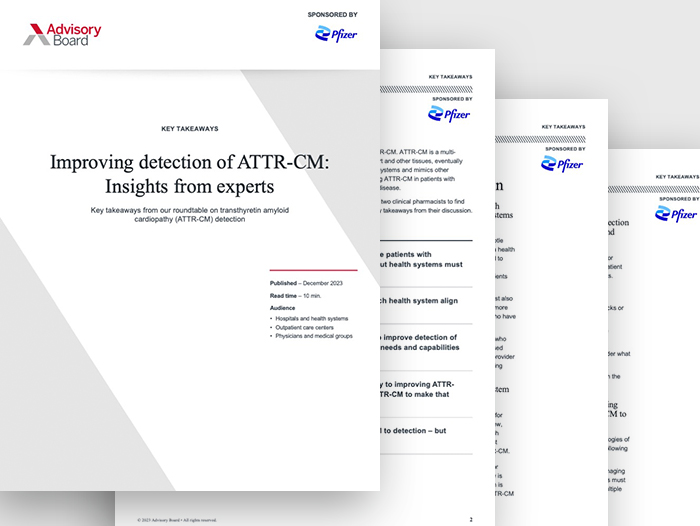In October 2023, Pfizer sponsored an interactive roundtable, Improving Detection of ATTR-CM. ATTR-CM is a multi-system disease characterized by the accumulation of misfolded amyloid fibrils in the heart and other tissues, eventually leading to heart failure and multi-organ dysfunction. Because it also affects non-cardiac systems and mimics other conditions, ATTR-CM can be difficult to diagnose before it becomes advanced. Identifying ATTR-CM in patients with earlier stages of cardiomyopathy can allow for timely diagnosis and management of the disease.
The event brought together heart failure specialists, cardiologists, a nurse navigator, and two clinical pharmacists to find alignment on the best approaches to improving detection of ATTR-CM. Read on for 5 key takeaways from their discussion.
Effective detection strategies ensure that heart failure patients with indicators of ATTR-CM are consistently screened — but health systems must consider their capacity to handle more patients.
Casting a wide net when screening for ATTR-CM is important, since it often has subtle symptoms that can be easily mistaken for other diseases. One way of assessing if a health system is screening enough patients is to compare the number of patients screened to patients diagnosed. At the event, participants suggested that a 10:1 ratio of patients screened to patients diagnosed indicates that providers are likely catching most patients with ATTR-CM.
But before deciding whether to expand screening for ATTR-CM, health systems must also consider their own capacity. If a health system doesn’t have the capacity to screen more patients, it may create a backlog that could unintentionally delay care for patients who have ATTR-CM.
An added benefit of a larger volume of screening is the potential to identify patients who don’t have ATTR-CM, but who are suspected of other rare or previously misdiagnosed cardiac conditions. Building in care pathways to route these patients to the correct provider will optimize patient care and help justify the resources allocated to a higher screening volume.
Simplified clinical criteria can help leaders within each health system align on when to suspect ATTR-CM.
Health systems are using many strategies to identify appropriate patients to screen for ATTR-CM, including standardized care pathways, centralized imaging or chart review, clinical decision support in the EMR, and provider education. But regardless of which approaches a system chooses to develop, simplifying which clinical criteria are most important for suspicion is foundational to building a system that better detects ATTR-CM.
Simplifying clinical criteria makes other strategies easier to develop and operate. For example, simplified clinical criteria can help guide how a standardized care pathway is mapped, including where it begins and how patients move through it. Or, if a system is focusing on provider education, simplified clinical criteria can make suspicion of ATTR-CM easier to teach and retain.
Standardized care pathways are a leading strategy to improve detection of ATTR-CM – but the right pathway will depend on the needs and capabilities of each health system.
Event participants identified standardized care pathways as a top system strategy for improving the detection of ATTR-CM. Standardized care pathways can make the patient journey — from suspicion to diagnosis to treatment — more consistent across patients. Though they are a compelling approach to ATTR-CM detection, standardized care pathways must be tailored to health system needs and capabilities, including:
- Health system capacity. Think about where a care pathway may create bottlenecks or backlogs.
- Entry, handoff, and exit points. Map entry and exit points into and out of the care pathway, as well as patient handoff points among clinicians and staff.
- Provider buy-in. Change management with any new process is critical, so consider what the health system will need to do to gain buy-in from providers.
- Patient access. The ability to conduct virtual visits or scheduling multiple tests on the same day can reduce patient travel time and ease patient access challenges.
Getting high-quality imaging right the first time is key to improving ATTR-CM detection – but we need strategies specific to ATTR-CM to make that happen.
Improving the entire life cycle of imaging is critical — from the technique and technologies of taking images, to the reading and interpretation of images, to communicating and following up on results.
Inadequate initial imaging can cause delays and obstructions to proper care. If re-imaging is required, imaging backlogs can delay diagnosis by weeks or months, and patients must find both transportation and time in their schedule to re-take images. In addition, multiple tests may not be reimbursable.
Ensuring that patients receive high-quality, first-round testing starts with addressing systemic challenges of imaging reliability. Solutions might include:
- Educating sonographers and radiologists to correctly take images specific to patients suspected of having ATTR-CM.
- Routing imaging for patients suspected of ATTR-CM through dedicated amyloid centers, where available.
- Building relationships with imagers who regularly provide high-quality images.
- Centralizing imaging reading, so that images are interpreted by readers trained to recognize ATTR-CM.
Both provider and patient education are foundational to detection – but education alone isn’t enough.
Creating awareness among primary care providers, general cardiologists, and hospitalists about when to suspect ATTR-CM is an important component of system detection strategies. The average time from initial symptoms to diagnosis of hereditary and wild-type ATTR-CM is 5.7 and 6.1 years, respectively — but when providers know when to suspect ATTR-CM in patients with heart failure, they can begin appropriate treatment much more quickly.1
Patient education is also an opportunity for improving detection because patients are uniquely positioned to notice seemingly unrelated symptoms. For example, if patients are aware that a medical history of bilateral carpal tunnel — combined with subsequent cardiac symptoms like shortness of breath — is a reason to be suspicious of ATTR-CM, they can proactively raise the issue with their PCP or cardiologist. In addition, improving patient education can improve patient follow-through on the next steps of diagnosis and treatment.
But while provider and patient education are important, they can’t stand alone. Because generalist providers already have many demands and see high volumes of patients primarily with more common cardiac diseases, relying on education alone as a detection strategy can unfairly place the burden on provider memory. Likewise, while patient education can help patients work with their providers to connect the disparate symptoms of ATTR-CM, reaching every high-risk patient with education isn’t feasible.
Nonetheless, education can make a significant impact when used in conjunction with other system strategies. For example, if a system implements clinical decision support in the EMR, provider education can ensure providers understand why a patient has been flagged and the next steps for care. Or patient education might support a standardized care pathways strategy by ensuring that patients understand the importance of timely follow-up on referrals and imaging appointments.
1.Rozenbaum et al., Impact of Delayed Diagnosis and Misdiagnosis for Patients with Transthyretin Amyloid Cardiomyopathy (ATTR-CM): A Targeted Literature Review, Cardiology and Therapy, 2021, 10(1).
At Pfizer we’re in relentless pursuit of breakthroughs that change patients’ lives. We innovate every day to make the world a healthier place.
Our unique resources allow us to do more for people. Using our global presence and scale, we’re able to make a difference in local communities and the world around us.
Pfizer supports the global healthcare community’s independent quality improvement initiatives to improve patient outcomes in areas of unmet medical need that are aligned with Pfizer’s medical and/or scientific strategies. For more information, please visit www.pfizer.com.
This report is sponsored by Pfizer, an Advisory Board member organization. Representatives of Pfizer helped select the topics and issues addressed. Advisory Board experts wrote the report, maintained final editorial approval, and conducted the underlying research independently and objectively. Advisory Board does not endorse any company, organization, product or brand mentioned herein.

This article is sponsored by Pfizer. Advisory Board experts wrote the article, and conducted the underlying research independently and objectively. Pfizer had the opportunity to review the article.
Don't miss out on the latest Advisory Board insights
Create your free account to access 1 resource, including the latest research and webinars.
Want access without creating an account?
You have 1 free members-only resource remaining this month.
1 free members-only resources remaining
1 free members-only resources remaining
You've reached your limit of free insights
Become a member to access all of Advisory Board's resources, events, and experts
Never miss out on the latest innovative health care content tailored to you.
Benefits include:
You've reached your limit of free insights
Become a member to access all of Advisory Board's resources, events, and experts
Never miss out on the latest innovative health care content tailored to you.
Benefits include:
This content is available through your Curated Research partnership with Advisory Board. Click on ‘view this resource’ to read the full piece
Email ask@advisory.com to learn more
Click on ‘Become a Member’ to learn about the benefits of a Full-Access partnership with Advisory Board
Never miss out on the latest innovative health care content tailored to you.
Benefits Include:
This is for members only. Learn more.
Click on ‘Become a Member’ to learn about the benefits of a Full-Access partnership with Advisory Board
Never miss out on the latest innovative health care content tailored to you.



